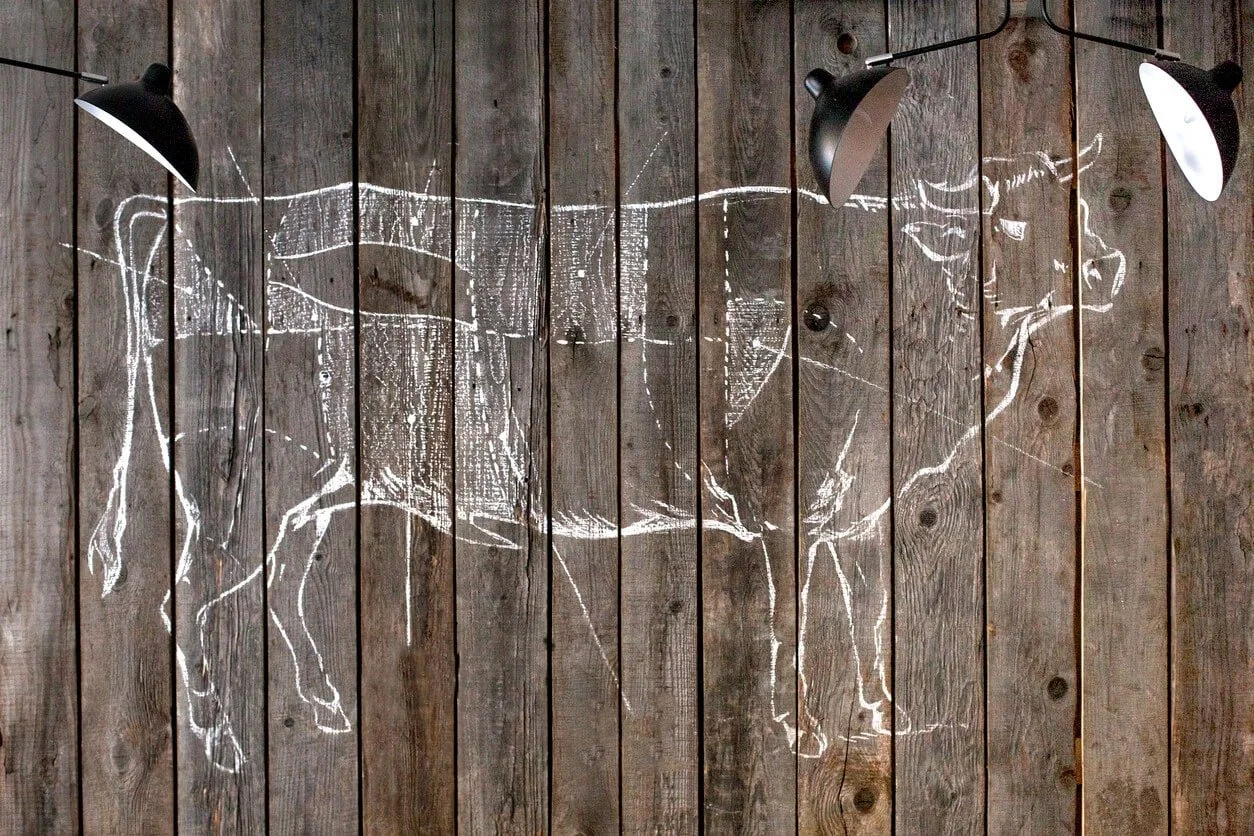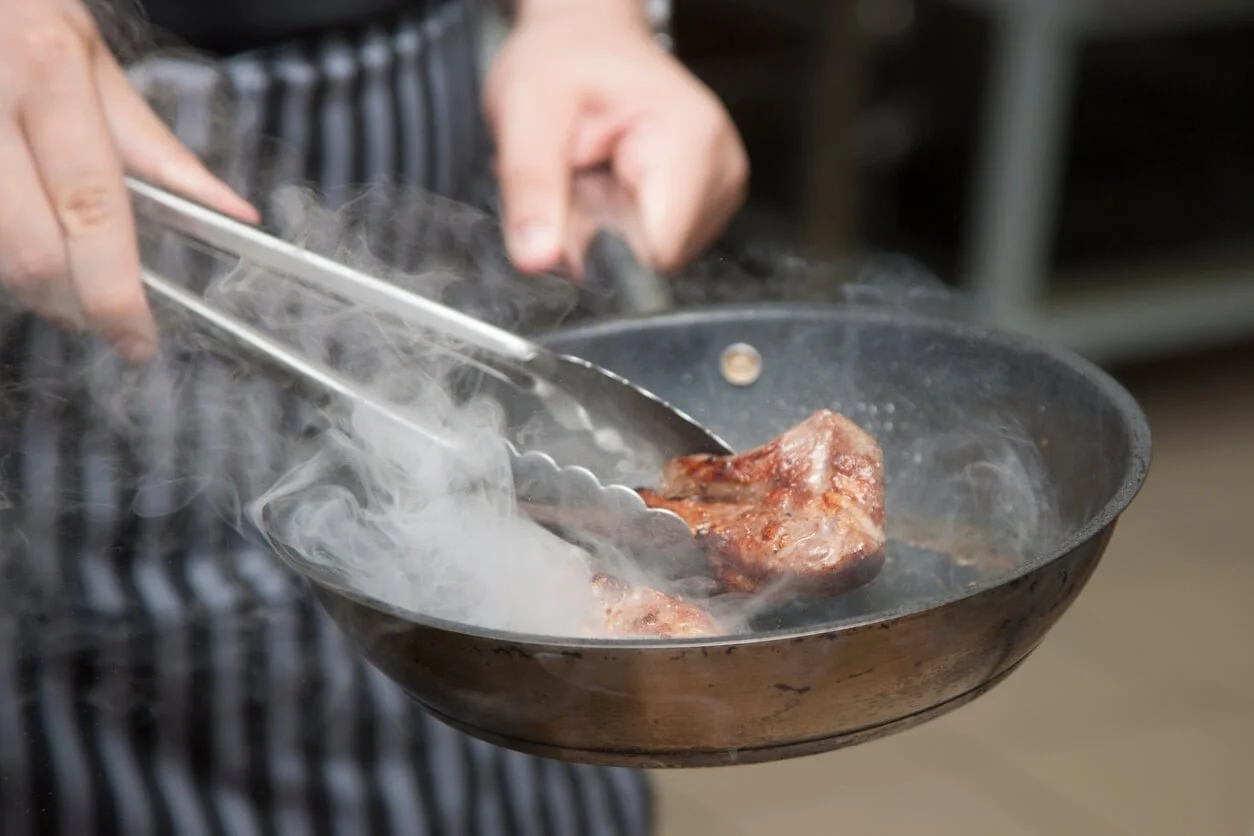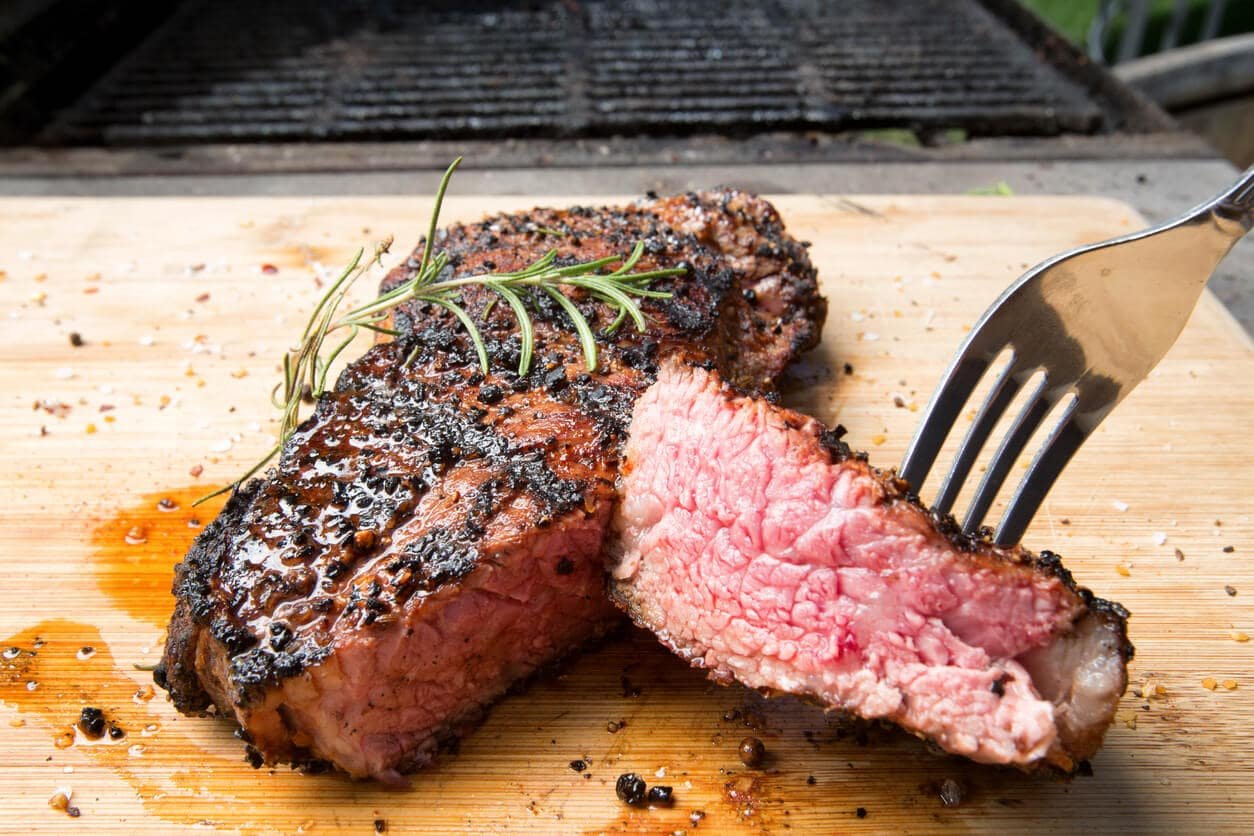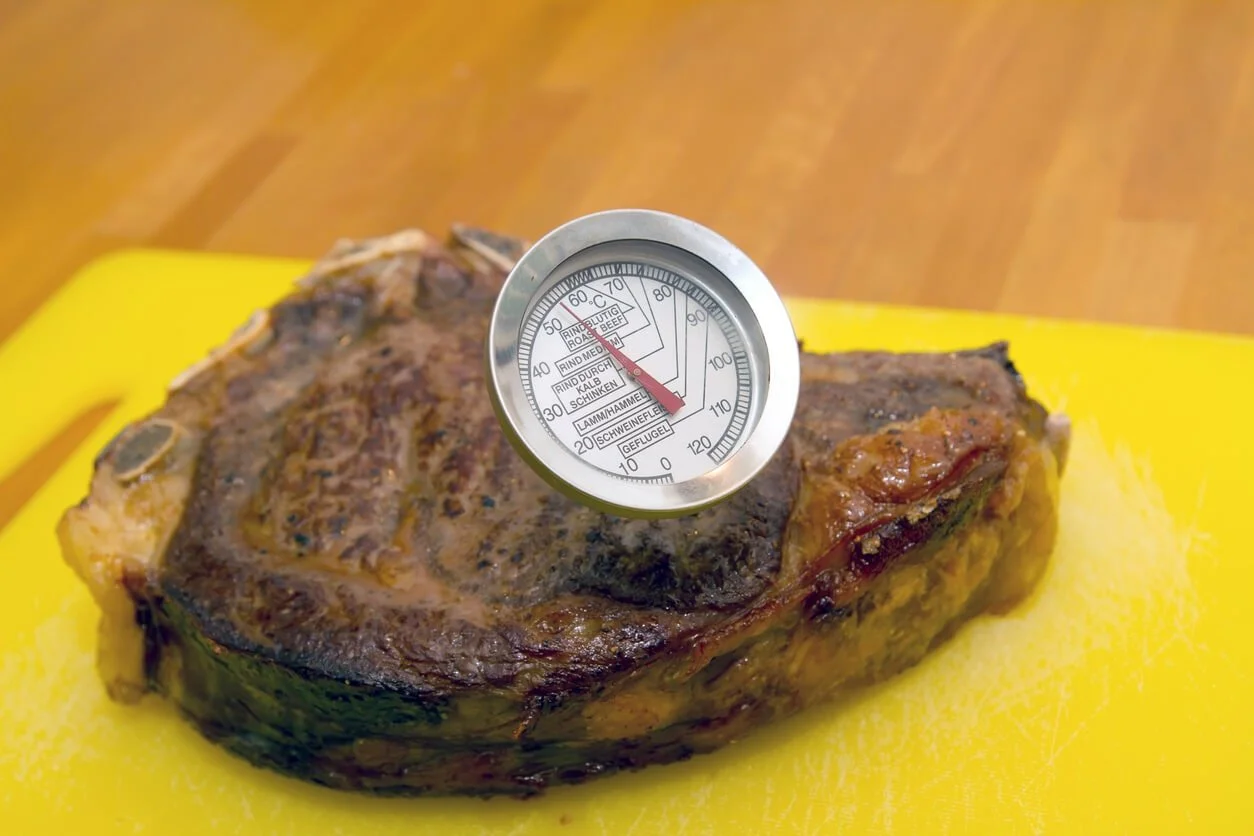The 3 Best Ways to Cook a Steak
Discover > Texas Home Cooking > The 3 Best Ways to Cook a Steak
Why steak has always been the epitome of Valentine's day dishes has always been a mystery to me. Maybe because according to the University of Texas, steak lean red meat (What wine goes well with red meat?) boosts dopamine and norepinephrine levels. It's also full of zinc, making it a potential aphrodisiac for men too. That’s why a lot of men (and women) want to learn the best way to cook a perfect steak to impress their loved ones.
I've cooked a lot of steaks throughout my career in every way you could possibly imagine from open fires to hot rocks or on the grill. Over time everything about cooking a steak becomes mechanical and soon enough you'll be able to test the doneness of the steak simply by pressing down on it with your fingers.
Cook a Perfect Steak: Which Cut is Worthy?
The cut of the steak you choose has a huge impact on what you prepare and how you prepare it. Different cuts have different textures, fat content, flavor, and unfortunately different prices. There is also a wide variation of breeds, farming methods, and places to get your steak that can also make even the slightest difference.
Cuts
If you want a really detailed list of all the different cuts of steak to cook a steak on a stove, check out this list to get a better idea of how things like fat content factor into the price and whatnot. I’ll take you through the best and my personal favorite cuts.
Keep in mind that with steak, price isn't everything. Many people prefer the texture and flavor of ribeyes over a filet mignon. Size is also a big determining factor; you can buy a $75 tomahawk that weighs over 3 pounds but unless you have a lot of experience cooking steak it can be tricky.
Filet Mignon
Filet mignons are top-of-the-line steaks and naturally the most expensive cut of steak per pound. It comes from the tip of the tenderloin which is by far the most tender cut of beef (how long does beef last?) and while it doesn’t have a huge amount of fat, it has beautifully even marbling throughout. Because of the lack of fat, it’s pretty easy to overcook and dry out, when you’re just learning how to cook the perfect steak indoors, but in return, you get a really beefy, rich flavor and texture.
Porterhouse/T-Bone
Both of these steaks are top-of-the-line and come from the same part of the back of the cow. The only difference is that a porterhouse has a large section of tenderloin on one of its sides. Porterhouse steaks can weigh well over 2 pounds which makes them perfect for sharing with just one downside. Because this steak is essentially made from two different cuts (the tenderloin and strip steak), and different cuts cook differently it can be difficult to cook perfectly throughout and quite challenging to learn how to cook a perfect steak on the grill.
Ribeye
Also known as the Entrecôte, Delmonico, and Scotch fillet, the ribeye is a southern favorite. You can buy ribeye bone-in (also known as a tomahawk) or boneless (I always recommend getting steak on the bone) and they can weigh anywhere from half a pound all the way up to 3 or 4 pounds. Certainly enough for two. Ribeyes come from the rib of the cow with a fine grain and beautiful pockets of fat that deliver amazing flavor and moisture, letting you cook a perfect steak.
NY Strip
The New York strip is a boneless steak cut from the short loin just behind the ribs. It’s got a generous amount of fat marbling and a very beefy flavor making it the best of both worlds. It has a fine grain (not as fine as a filet or ribeye) and is one of the easiest steaks to cook.
Farming Methods
The two big ones currently gripping the beef argument are grain-fed factory-farmed beef vs grass-fed beef. There are many more farming methods that affect the quality of beef, wagyu cows, for example, live a life of luxury, therefore, have incredibly tender and tasty beef. It can also be confusing to look for all these different methods because they’re intentionally not made very clear. There is a very big difference between grass-fed and grass-finished beef.
Ethical arguments aside, grass-finished beef has a much more beefy flavor than grain-fattened stiers. This is because grass-fed beef has less fat than generic beef, on the other hand, grass-fed beef has a far better omega-3 to omega-6 fat ratio which is far better for our bodies and digestion.
Dry Aged Beef
I highly, highly, highly recommend buying dry-aged beef for something as special as a significant other. It can get pricey especially when you're buying a huge cut that requires long periods of aging.
Dry aging beef essentially consists of storing the beef in a temperature-controlled cooler (between 34.7 and 35.6 degrees Fahrenheit) anywhere from a week up to 4-5 months. During this time water evaporates which concentrates the flavor of the beef and enzymes naturally occurring in the beef start to break down the meat’s connective tissue for a more tender steak.
Herbs and Spices You Should Use
When you're going for top-of-the-line meat to cook a perfect steak, it’s always good to match the other ingredients where you can. When you buy a great cut of steak it’s always best to let the meat speak for itself. While there’s absolutely nothing wrong with a tasty dry rub or saucy marinade, letting the beef shine through never hurts (unless you have low-quality beef).
Seasoning the meat generously with salt is a must. The best way to salt a steak is to rub the meat with kosher salt (how long does kosher salt last?) and then leave it to soak into the meat for up to a couple of hours. The salt will draw water out of the beef, dissolve the salt in the water, then the meat reabsorbs the salty water seasoning the entire cut.
February is a great month for fresh herbs (how long do fresh herbs last?) because it’s the transition from the colder months to the warmer months so you can basically have a frenzy. My favorite herbs to season steak with are rosemary and thyme especially with some fresh garlic to even out the flavor.
1.) Reverse Seared
How to cook the perfect steak indoors? A reverse sear ensures you get a perfect interior before searing the steak and basting it with seasoned butter. A small downside to reverse searing is that searing the steak after it’s been baked in the oven is a game of time. Searing 30 seconds to a minute extra can mean the difference between a medium and a medium-rare steak.
How to Reverse Sear
Fire up the oven between 200 and 275°F. The lower the temperature the more evenly the beef will cook and the longer it will take.
Place the steaks on a wire rack and bake them in the oven until the internal temperature is between 10° and 20° Fahrenheit below how well you like your steak done.
Remove the steaks from the oven and place a skillet over a medium-high flame and heat some oil.
Once the oil is hot add a couple of tablespoons of butter and whichever herbs and spices you're using to infuse the oil then lay in the steak and sear both sides while basting consistently.
Let the steak rest for 10 minutes before serving them.
2.) Fire-Grilled
If you’re a fan of smoked meat and BBQ this is definitely the way to go. You can certainly use this method to reverse sear as well, but cooking the steak entirely over wood or charcoal will give it a smokier flavor.
How to Cook a Perfect Steak on the Grill?
Grilling is a great opportunity to perfectly cook up a porterhouse. Since one side of the steak cooks faster than the other grilling on one side indirectly makes the process slightly easier.
Fire up the grill and let your charcoal whiten before laying the beef onto the grill and simply cooking the steak on either side until the internal temperature reaches your desired amount.
Seasoning the steak with fresh herbs can be difficult although there are some ways. I recommend chopping up fresh herbs and grinding spices then mixing those ingredients into butter. Use a pastry brush to brush the top of the steak every few minutes to baste and season the beef.
3.) Sous Vide
Sous vide is probably the only true way to cook anything perfectly every time because it essentially takes any human error out of the equation and doesn't leave anything up to chance like the fluctuating temperature of an oven would. Sous vide steak also has to be seared after it’s cooked which is really the only 5 minutes window where you have to focus.
How to Sous Vide a Perfect Steak
Set up your sous vide bath and let it come up to the correct temperature.
Bag up your cut of steak and optionally add some thyme or rosemary sprigs.
Seal and vacuum the bags, drop them into the water bath, and cook them between 1 and 3 hours depending on the size and thickness of the steak.
After you remove the steak from the bath repeat the steps to sear the steak the same way you would for a reverse sear.
Wines to Pair With Steak
Beef is salty, fatty, and umami especially when it’s dry-aged. Pairing with a sweet, acidic, tangy wine really ties a steak dinner together. Here are some things to take into account when choosing a wine to pair with your steak:
Fattiness
The fattier the cut of beef you're using, the less robust and rich you want your wine paring to be. Acidity is parallel to fattiness on the taste chart. Red wines are generally not as acidic as white wines, but some of the conditions that determine acidity are the climate in which the grapes are grown, when the grapes are harvested, the soil in which the grapes are grown, and how long they’ve been aged.
Seasoning
You can pair almost any red wine with a salt simply seasoned with salt and pepper although in that case, it’s better to go for full-bodied, sweet wine. Things get a little more complex when adding herbs, spices, garlic, and butter to the mix. If you cook a very heavily seasoned steak, look for a lighter, sweeter, and fruitier wine.
White Wines
It’s a myth that you have to pair red meat with red wine similarly that you can drink plenty of red wine with things like fish or poultry. It’s slightly harder to pair but many wine experts say it’s very possible and quite enjoyable.
White wines are more acidic than red wine so it could be good to pair a white with a particularly fatty steak like a ribeye. Pair medium and full-bodied whites with your steak. It’s a weirdly taboo subject so do your own research and experiment yourself, there is no written rule that says white wine doesn't go with red meats.
Steak Cooking Tips
Season Hours Before Cooking
This is also known as dry brining; it works by using salt to draw water out of the meat. While on the surface, salt dissolves in the water which then gets reabsorbed into the meat as a brine seasoning the steak throughout.
Use a Meat Thermometer for Accuracy
Ultimate accuracy when it comes to meat requires a meat thermometer. The best you can buy is a wireless probe thermometer that you can insert and leave in the meat. This helps a lot, particularly with huge steaks where it’s harder to tell by pressing on the meat.
Don't Sear Directly in Butter
Melt the butter in olive oil or something with a higher smoke point. If you try to sear with just butter it will burn and won’t taste very nice.
Use Local and Ethically-Raised Beef
No matter where you live in America you can get your hands on locally raised beef. Whether that requires you to buy directly on a farm or online or through a farmers market.
Cook a Steak From Room Temperature
While this is highly debated among meat lovers it doesn’t have a massive impact on regular-sized steak. On the other hand, steaks that weigh 4 pounds are very easy to ruin so making sure all that meat is at room temperature is important.
Always Rest a Steak
Another hot topic of debate about how to cook a perfect steak among cooks and meat-eaters alike is whether to rest or not to rest. Rest the meat. The argument against resting is all about moisture loss after cutting into the beef, and while resting does in fact assist in moisture retention, it’s not the only factor. When you rest the meat the residual heat will continue to slowly cook the beef and the muscle fibers will relax for a tender steak.








